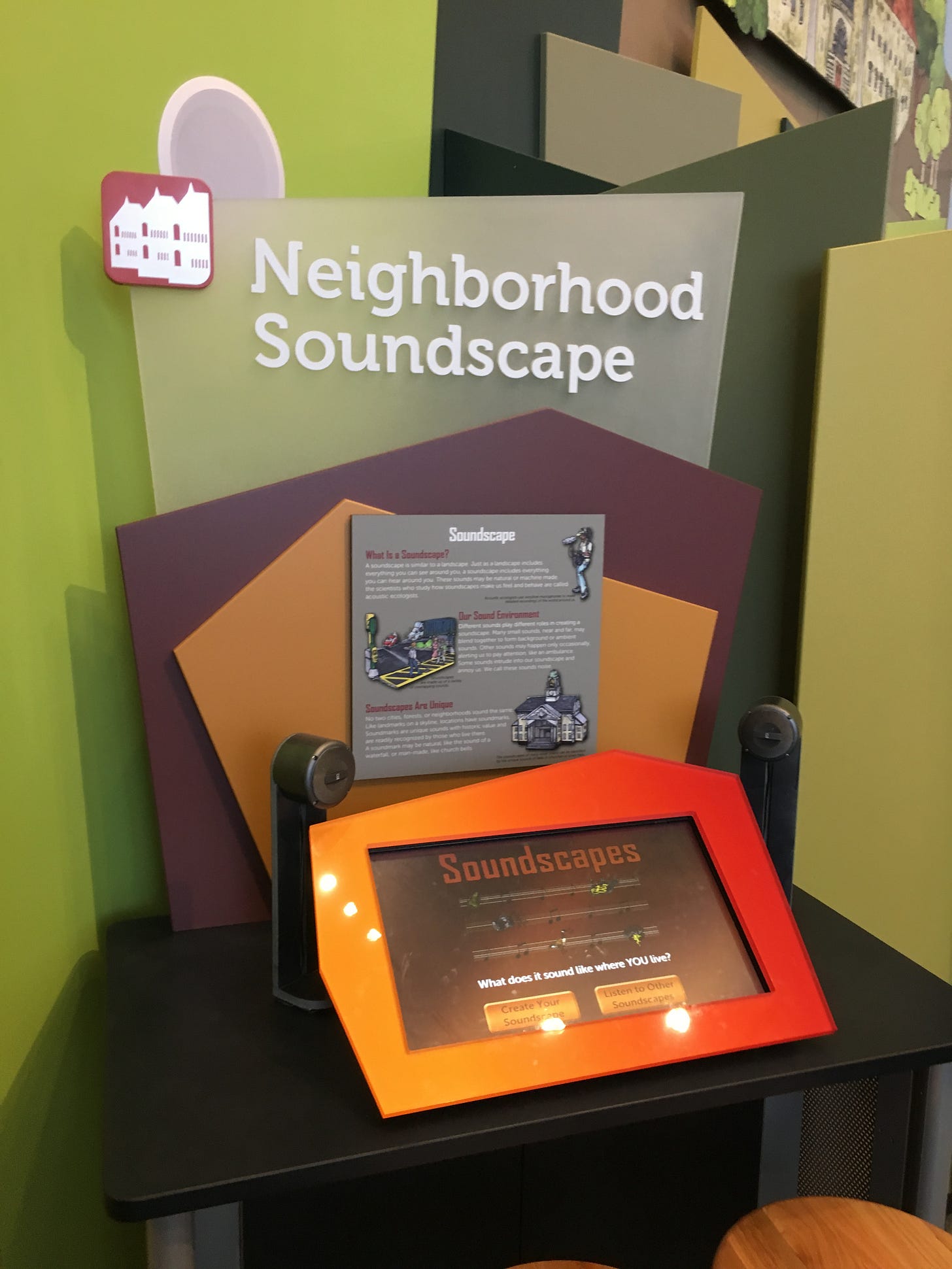Raise your hand if you spent Covid-lockdown times thinking about using the non-touch senses in your exhibits. Me, too! Today, I’m focusing on the power of sound as a tool for engagement. A good deal of this information came to me well before the plague, but the lessons keep coming in handy.

Sound is Memory
Whether you’re on Team Museum or Team Planner, one way to get people thinking about their environment in a new way is to focus on their sonic experiences and memories. If you have typical hearing, you are taking in and storing a lot of information aurally - even when you’re not aware that you’ve taken that information in. Think about the people, or pets, in your life that you identify by their footsteps. You can probably even hear the difference between hot vs cold water being poured. (Test yourself!) So sound is there in the memory banks - if we can tap into it.
Sound is Imagination
The Exhibits team at the EcoTarium discovered the potential of sound as a compelling exhibit hook when we were conducting the front-end evaluation (that’s “early R & D” in non-museum-speak) for the City Science exhibit. We’d recently attended a workshop about family learning conducted by the USS Constitution Museum. In a warm-up exercise, we were presented with a circa 1905 photo of a city intersection and the prompt, “What would you hear here?” Immediately, we could hear the screech of trolley wheels, the clip-clop of the dairy cart horses’ hooves, the yell of the newsboy on the corner – the whole historic urban soundscape. So, sound is also there in our imaginations.
Sound Can Be Personal
Inspired by that experience and by the Chicago History Museum’s sensory map, we asked people in focus groups to think about our city, Worcester, MA, using their senses, along with the usual standbys like “What do you love …” “What would you change…” For the most part, we got very consistent answers. But “What does Worcester sound like?” was the one question where we got very disparate responses. Clearly your aural experience in the City varied with your neighborhood – and with your other life experiences.
Intrigued, we created two different interactives about sound in City Science. Evoking our experience with the historic photo at the family learning workshop, “Neighborhood Soundscape” asks people to create the soundscape of their neighborhood. The second, “Noise Pollution”, I’ll explore in my next post.
Sound is Information
From our perspective as creators of STEM learning experiences, “Neighborhood Soundscape” meshed perfectly with a show in our planetarium called Global Soundscapes which explored the science of sound. One compelling section of the show drives home the fact that sound is data. In places like the Amazonian rainforest, researchers can identify and count far more frogs, insects, birds, and mammals by sound than by sight. In recordings taken five years apart at the same spot of entire swaths of the soundscape go missing after deforestation.
With “Neighborhood Soundscape”, visitors think about the natural and human-caused sounds that surround them daily, and what those sounds tell them about their homes. Adults used prompts like “Right - we hear airplanes. Are they close and or far away? Okay, let’s make them quieter.” If you missed it, you can read about the tweaking we did to the prototype of the interactive to get this kind of engagement, in my post Getting Geeky About Goals (Part 1)
Sound In Planning
In my post about building model cities, I mentioned the work of James Rojas and John Kamp of the Place It! Interactive Planning consultancy. Reading their book, Dream, Play, Build, I was delighted to see that they conduct sensory neighborhood tours as part of their community engagement process. They deliberately plan their tour routes help people re-experience their familiar surroundings through “changes in temperature, light, shade and shadow, hard and soft surfaces, sounds of all kinds and volumes”. In correspondence with me (thanks James & John!), they report that people on the walks and in their model building workshops frequently note the difference in the sounds in, say a solidly residential area and commercial corridor, and how each soundscape makes them feel.
Which gets us to the topic of next week’s post. How we experience sound, and whether we consider it noise or even noise pollution, is not just a matter of decibels and frequencies. Be sure you’re subscribed to get next week’s article in your in box. It’s free to subscribe, but if you’re inclined to pledge to be a supporter, that would be lovely!
In the meantime, find a couple of times to sit, eyes closed, and just listen. How many different sounds can you identify? What’s different the second time? And, of course -if you are working on a project that uses sound as a tool for engaging people to think about their town or city – let me know!
~ Betsy Loring1
The Planning-Curious Museum Person
Sharing stories and ideas for other Planning-Curious Museum People and for Museum-Curious Planning People. If you’re already collaborating, tell me about it! Interested in expLoring a collaboration with me? Let’s talk!
Betsy Loring is founder of expLoring exhibits & engagement. She has over 20 years’ experience in project management and exhibit development in multidisciplinary, indoor and outdoor museum settings. Her services include exhibit master planning, content and interactive development, and writing, with a focus on hands-on STEM. She also offers staff training in exhibition planning, formative evaluation, and prototyping. Special interests include multi-institutional collaborations, peer-to-peer professional development, and of course – collaboration with municipal planning practitioners.





